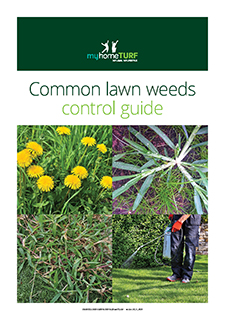What are Perennial Weeds?
Perennial Weeds are longer lived plants that can survive winter or regrow from roots, rhizomes or tubers in spring after a period of dormancy. Many weeds that grow from seed ...

Paspalum can be a very difficult weed to kill in most Australian lawns, and continues to be one of the most hated weeds in the country.
Once established in a lawn it has the ability to grow low and beneath lawn mower blades, enabling it to continue spreading unchecked.
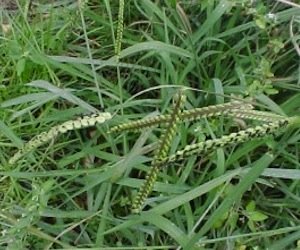
Paspalum is a tufted perennial weed mostly found in the South Eastern states of Australia, where it can grow to over a metre tall in the wild or in garden beds. Known by alternative names, including caterpillar grass, millet grass, common paspalum, Dallis grass, hairy flowered paspalum, large watergrass, Leichhardt grass, this highly adaptable weed type will completely change its growing habits when grown in a home lawn that is regularly mowed.
Paspalum is a summer-active weed, that flowers from October to April. Seeds germinate in moist warm months. Paspalum weeds often taking two to three years to reach their first flowering.
Paspalum will grow seed-producing stems, each with 3 -7 tassel-shaped seed-bearing heads that are pendulous in nature The heights of Paspalum stems vary depending on the regularity of lawn mowing and how high the lawn is cut.
Paspalum self-seeds voraciously, producing sticky seeds that stick to animals and shoes, enabling them to be transported easily to new locations. Once established, paspalum clumps are difficult to eradicate.
There are several varieties of Paspalum, including Bahia Grass and Water Couch. All three varieties have similar characteristics – common paspalum grows to 1m, while Bahia grass is a lower growing variety, and water couch is mostly found near waterways.
While regular lawn mowing should be able to control and stop this weed from spreading through the regular removal of its seeds, Paspalum simply stops growing higher and instead begins to creep along the ground.
Paspalum is regarded as an environmental weed in most Australian states.
Paspalum can be killed in Couch lawns with a selective weed killer which can be purchased at the local nursery or myhomeTURF’s online store. The same herbicide can also be used on other lawn types such as Ryegrass, Fescue and Bentgrass.
Paspalum cannot be killed in Buffalo or Kikuyu lawns with the use of selective herbicides.
This leaves lawn owners with real problems in trying to control Paspalum. Lawn owners facing this problem should tackle Paspalum as soon as the weed is spotted in the home lawn, and before it spreads.
Paspalum can be removed with a sharp knife at the base of the plant, cutting it underneath soil level and into the roots. No need to turn it into a massive single job, half an hour in the garden once a week will remove the weeds with little effort.
Paspalum can also be killed with a Glyphosate broad-spectrum weed killer, which is mixed in a small stable container.
The herbicide is then painted onto the Paspalum with a small paintbrush, or by dipping a rubber-gloved hand into the herbicide and wiping the weed with the glove. Be very careful not to spill any Glyphosate onto the lawn, as it will kill any plant it encounters, including lawns.
There are several herbicide products that are effective in the control and management of Paspalum in your lawn. These products are available from your local garden centre or via myhomeTURF’s online store.
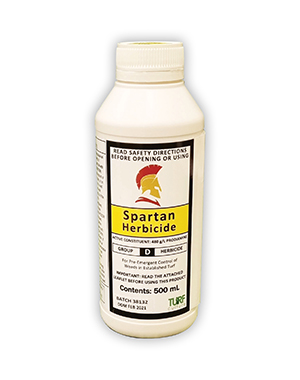
Spartan is one of the leading pre-emergent herbicides for the control of Paspalum. Spartan is suitable for use on Zoysia, Kikuyu, Couch and Buffalo grasses. Always read the safety directions and instructions on the product label before use.
SHOP NOW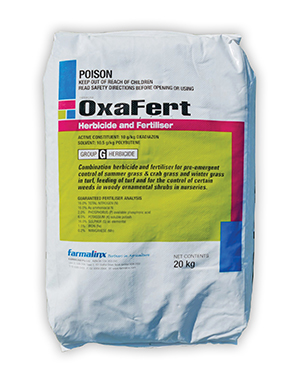
Oxafert 16-2-6 20kg is a combined Fertiliser and pre-emergent Herbicide product for the control of paspalum and an application of an NPK Fertiliser. Oxafert is suitable for use on Zoysia, Kikuyu, Buffalo and Couch grasses. Always read the safety directions and instructions on the product label before use.
SHOP NOW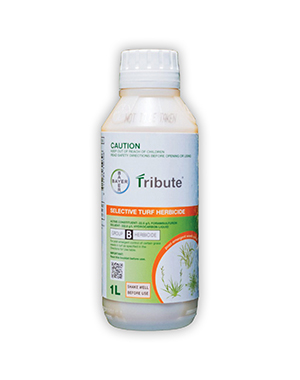
Tribute 1L is a post-emergent selective herbicide that controls Paspalum in lawns. Tribute 1L Herbicide is only suitable for use on Zoysia and Couch lawns and CANNOT be used on Queensland Blue Couch, Buffalo and Kikuyu lawns. Always read the safety directions and instructions on the product label before use.
SHOP NOW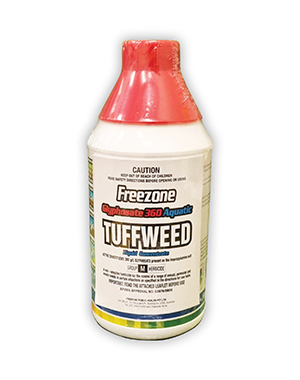
TUFFWEED Liquid Glyphosate 1L super concentrate is a non-selective herbicide that combats the toughest of weeds. Extreme care needs to be taken when applying as a non-selective herbicide TUFFWEED will control any plant that comes in contact with. Always read the safety directions and instructions on the product label before use.
SHOP NOWPaspalum weeds are a troublesome weed that is hard to eradicate once it takes hold in your lawn. A summer-active weed, it can grow up to a metre tall. Once established, paspalum is a prolific seeder, so you aim to control it quickly. If you have a Couch, Ryegrass, Fescue or Bentgrass lawn, there are a range of selective herbicides that you can use to kill paspalum. Unfortunately, these same herbicides cannot be used in Buffalo and Kikuyu, so weeds must be removed manually, or treated individually with a broad-spectrum herbicide.
For more information on leading herbicide treatments for your home lawn, visit myhomeTURF’s online store.
Sign up for our Newsletter to receive your free guide.
